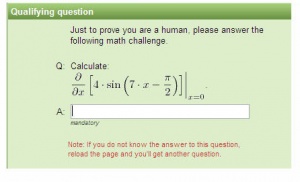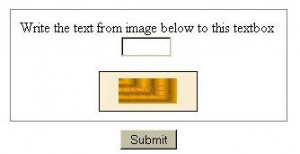CAPTCHA
From Computing and Software Wiki
(Difference between revisions)
| Line 1: | Line 1: | ||
| + | CAPTCHA is an acronym for '''C'''ompletely '''A'''utomated '''P'''ublic '''T'''uring Test to Tell '''C'''omputers and '''H'''umans '''A'''part. Commonly, these tests take the form of images of scrambled text that a human is able to read, but current optical character recognition software cannot decipher. The most common use of a CAPTCHA is to protect web-accessible services from being abused by "bots". | ||
| + | |||
| + | ==Background== | ||
| + | |||
| + | ==Weaknesses== | ||
| + | |||
| + | ===Poorly Made CAPTCHA=== | ||
| + | |||
| + | A CAPTCHA can be described as ''poor'' in one of two ways. Either the test fails to be human-solvable in a reasonable amount of time, or it can be solved by a computer using current AI techniques. To the right are two CAPTCHA that fall under the first category. | ||
| + | |||
<div style="float:right;width:315px;"> | <div style="float:right;width:315px;"> | ||
[[Image:Sin_captcha.jpg|thumb|300px|A particularly poor CAPTCHA]] | [[Image:Sin_captcha.jpg|thumb|300px|A particularly poor CAPTCHA]] | ||
[[Image:Unreadable_captcha.jpg|thumb|300px|Another poor CAPTCHA]] | [[Image:Unreadable_captcha.jpg|thumb|300px|Another poor CAPTCHA]] | ||
</div> | </div> | ||
| + | |||
| + | ===Accessibility=== | ||
| - | == References == | + | ==References== |
# Carnegie Mellon University. 2009. [http://recaptcha.net/captcha.html What is a CAPTCHA?]. | # Carnegie Mellon University. 2009. [http://recaptcha.net/captcha.html What is a CAPTCHA?]. | ||
# Luis von Ahn, Ben Maurer, Colin McMillen, David Abraham and Manuel Blum. 2008. [http://www.cs.cmu.edu/~biglou/reCAPTCHA_Science.pdf reCAPTCHA: Human-Based Character Recognition via Web Security Measures]. In ''Science''. | # Luis von Ahn, Ben Maurer, Colin McMillen, David Abraham and Manuel Blum. 2008. [http://www.cs.cmu.edu/~biglou/reCAPTCHA_Science.pdf reCAPTCHA: Human-Based Character Recognition via Web Security Measures]. In ''Science''. | ||
Revision as of 19:34, 6 April 2009
CAPTCHA is an acronym for Completely Automated Public Turing Test to Tell Computers and Humans Apart. Commonly, these tests take the form of images of scrambled text that a human is able to read, but current optical character recognition software cannot decipher. The most common use of a CAPTCHA is to protect web-accessible services from being abused by "bots".
Contents |
Background
Weaknesses
Poorly Made CAPTCHA
A CAPTCHA can be described as poor in one of two ways. Either the test fails to be human-solvable in a reasonable amount of time, or it can be solved by a computer using current AI techniques. To the right are two CAPTCHA that fall under the first category.
Accessibility
References
- Carnegie Mellon University. 2009. What is a CAPTCHA?.
- Luis von Ahn, Ben Maurer, Colin McMillen, David Abraham and Manuel Blum. 2008. reCAPTCHA: Human-Based Character Recognition via Web Security Measures. In Science.
- Luis von Ahn, Manuel Blum, Nicholas Hopper, and John Langford. CAPTCHA: Using Hard AI Problems for Security. In Eurocrypt.
- Luis von Ahn, Manuel Blum and John Langford. 2004. Telling Humans and Computers Apart Automatically. In Communications of the ACM.
- W3C. 2005. Inaccessibility of CAPTCHA.
- Willis, John M. 2008. Top 10 Worst Captchas.


